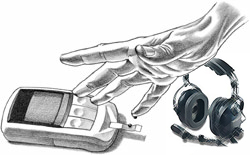Diabetes: Monitoring
Actions Required During Flight Operation

FAA Disease Protocols
Diabetes Mellitus - Type I or Type II, Insulin Treated
Monitoring and Actions Required During Flight Operations
To ensure safe flight, pilots who use insulin must carry a recording glucometer while airborne; the airman must also carry adequate supplies to obtain blood samples; and an amount of rapidly absorbable glucose, in 10 gm portions, appropriate to the planned duration of the flight. The following actions shall be taken in connection with flight operations:
- One half hour prior to flight, the airman must measure the blood glucose concentration. If it is less than 100 mg/dl the individual must ingest an appropriate (not less than 10 gm) glucose snack and measure the glucose concentration one half hour later. If the concentration is within 100 -- 300 mg/dl, flight operations may be undertaken. If less than 100, the process must be repeated; if over 300, the flight must be canceled.
- One hour into the flight, at each successive hour of flight, and within one half hour prior to landing, the airman must measure their blood glucose concentration. If the concentration is less than 100 mg/dl, a 20 gm glucose snack shall be ingested. If the concentration is 100 -- 300 mg/dl, no action is required. If the concentration is greater that 300 mg/dl, the airman must land at the nearest suitable airport and may not resume flight until the glucose concentration can be maintained in the 100 -- 300 mg/dl range. In respect to determining blood glucose concentrations during flight, the airman must use judgment in deciding whether measuring concentrations or operational demands of the environment (e.g., adverse weather, etc.) should take priority. In cases where it is decided that operational demands take priority, the airman must ingest a 10 gm glucose snack and measure his or her blood glucose level 1 hour later. If measurement is not practical at that time, the airman must ingest a 20 gm glucose snack and land at the nearest suitable airport so that a determination of the blood glucose concentration may be made.
Return to Index of Specific Conditions
Return to Part 67 Index
Go Find an AME

